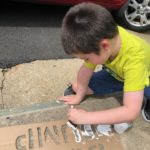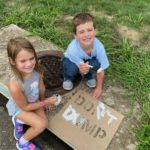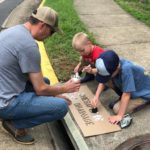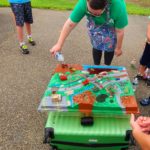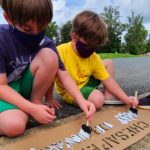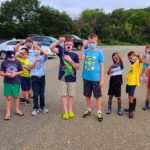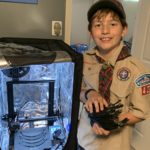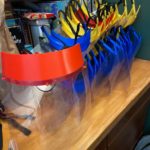Today, Pack 22 took advantage of the amazing weather and gathered for a conservation project. We were joined by Mariya from Tri – County / City Soil & Water Conservation District for a fun craft and demonstration of the water cycle. Afterwards, our Scout families marked watershed spots in a nearby neighborhood.
Invasives Wanted – Dead Not Alive
Scouts BSA Troop 1191G of Francis Scott Key District, NCAC worked to clear invasive species from their local Windy Ridge Park trail with the Town of Mount Airy Naturalist. By working with the town Naturalist, Scouts started to identify invasives and how they were suffocating the native plant life. With this new knowledge, they worked to clear areas of invasives to allow native plants to thrive in their natural habitat. Scouts worked to clear invasive plants such as multiflora rose, oriental bittersweet, and Japanese stiltgrass. This allowed Scouts to appreciate a number of small native snapdragons that would normally be wiped out by invasives. The most triumphant save of the day was a mature mulberry that was being suffocated by a large oriental bittersweet. Several large piles of invasive plants are destined to be picked up this week by the town for disposal. #ScoutsBSATroop1191 #ScoutingContinues #givingbacktothecommunity
Cub-A-Day Program Week 12 (August 24-29)
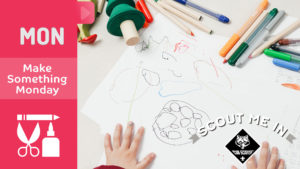
MONDAY
Draw or paint a picture, make a PowerPoint type slide, or create some other project that highlights your favorite part of the summer. Once it’s dry or ready – Take a photo and post it for everyone to see and then keep it safe in your memory box from Week 1.
Webelos can work on Art Explosion Requirement 3 with this project.

TUESDAY
Hydration is key for everyone, especially Cubs Scouts on the go!
Water is the best way to be hydrated, but have you tried infusing water with different fruits? Try it out with your favorite berry or citrus fruit. How does it taste? You can also use melons or cucumbers for a different flavor.
Here are some more ideas: https://www.tasteofhome.com/collection/infused-water-ideas/
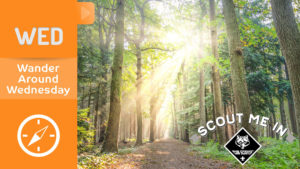
WEDNESDAY
If you haven’t yet – Ask a family member to download the “iNaturalist” app and then take a hike and “capture” 5 plants and/or animals you’re not familiar with.
Share with your den and/or pack about the new species you learned about.
If you are unable to download the app, take photos of the species and research online to identify them.

THURSDAY

FRIDAY

SATURDAY
Each rank has different requirements for the Emergency Preparedness Award – Take a look at which requirements your family has completed, and what you have left to do.
Finish up any outstanding items and submit them to your den leader – You’ll be better ready for any emergencies that arise, and you can earn a cool pin to show off your new skills.
Cub Scouts Make Face Shields & Ear Relief Bands for Teachers
At the start of the COVID-19 shut down, Cub Scout Pack 42 started a program using 3D printers owned by a handful of our Scout families to print ear relief bands and face shields for health care workers. This fall, we have shifted gears and are now printing a combination of these items for local teachers who are returning to in person educating at the start of this school year for at risk students. Our Pack has raised funds for this project and through the generosity of our families we have been able to fully fund printing efforts. To date we have provided 670 items to health care workers and are working towards a minimum of 300 face shields and 300 ear relief bands for teachers.
Cub-A-Day Program Week 11 (August 17-22)
MONDAY
Theaters are an important art venue and provide all sorts of entertainment.
This week we are going to make hand puppets – You can use a sock, a paper lunch bag, paint, markers, or any other materials you’d like (and the adults in your house approve) to design a puppet for your hand.
PS – You’ll need it later this week!

TUESDAY
Fruits and vegetables are important for a balanced diet. Dietitians agree the more color you have on your plate, the healthier the meal.
So today, put together a colorful lunch, using at least one “new to you” fruit or vegetable. Post a photo of what you try and how it was!
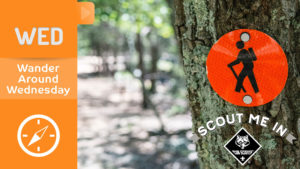
WEDNESDAY
Pick a town, county, or state park you have not been to. Plan and take a hike/walk at that park. Don’t forget your Cub Scout hiking essentials!!

THURSDAY
Take some time and listen to a new style of music.
Did you enjoy it? How did it make you feel?
Write down your thoughts and feelings and share this new music with your family, den, or pack.
Webelos – If you can find a live music broadcast, or a recording, you can satisfy Maestro Requirement 1(a).

FRIDAY
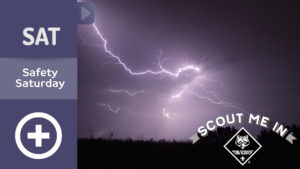
SATURDAY
Talk with your family about what to do during severe weather in your area – We see thunderstorms with heavy rain, hail, and high winds during the summer and can get heavy snow and ice during the winter.What other types of serious weather can we get in the National Capital Area Council?
Orienteering Sept. 12
The 44th Annual Balto. Area Council MD Scout Orienteering Day is at Broad Creek Scout Res. (Camp Oest, 35 mi. NE of Balto.) on Sat., Sept. 12. This is a changed date & location. This event is limited this year to MD units only and a minimum of six scouts per troop due to COVID mitigation rules (which will be sent to each unit registering, reinforced by a phone call from the event chair.)
Last year #myNCAC Scouts had their usual great results, with nine of the top twelve troop awards. Troop 111 from Chain Bridge District, Arlington, was the top NCAC troop. Nate Beardmore of Troop 347, Western Shores (Prince Frederick) was the overall winner. We had 70 units last year; this year we’ll cap registration at 24 units.
Register online by Sept. 3, $4 per person (patch, 2 color maps.) No Cubs, no Webelos. If interested in camping, contact Chris at CWetzel@BaltimoreBSA.org or 443-573-2523. Self-guided map instruction starts off this 3-hour program, designed for beginners to this forest navigation map sport. Before or after your 3-hour orienteering time slot (which we’ll arrange with you in advance) troops may chose to hike some of the camp’s nice creekside, lakeside, or old growth hemlocks trails.
And save the date: Oct 23, 2021 for next year’s event at Patuxent River Park near Upper Marlboro.

